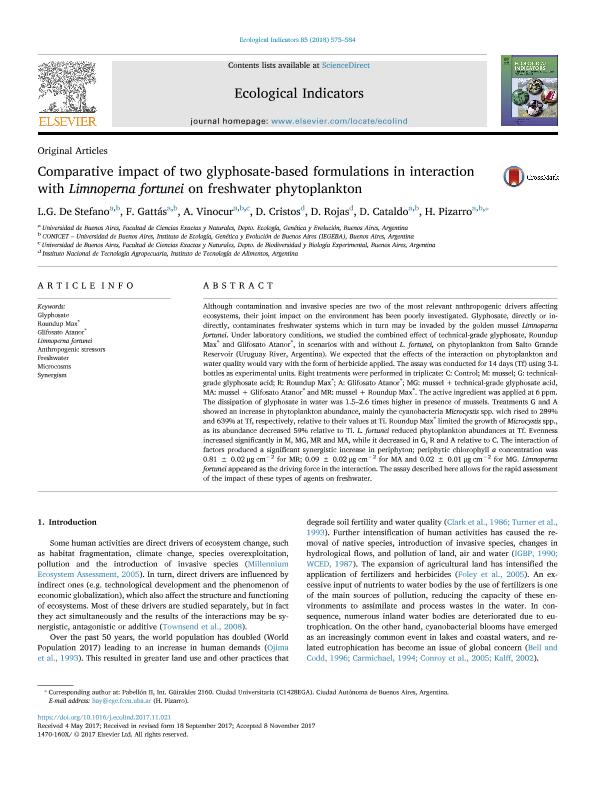Artículo
Comparative impact of two glyphosate-based formulations in interaction with Limnoperna fortunei on freshwater phytoplankton
de Stefano, Lucia Gabriela ; Gattás, Florencia María; Vinocur, Alicia Liliana; Cristos, Diego Sebastián; Rojas, D.; Cataldo, Daniel Hugo
; Gattás, Florencia María; Vinocur, Alicia Liliana; Cristos, Diego Sebastián; Rojas, D.; Cataldo, Daniel Hugo ; Pizarro, Haydee Norma
; Pizarro, Haydee Norma
 ; Gattás, Florencia María; Vinocur, Alicia Liliana; Cristos, Diego Sebastián; Rojas, D.; Cataldo, Daniel Hugo
; Gattás, Florencia María; Vinocur, Alicia Liliana; Cristos, Diego Sebastián; Rojas, D.; Cataldo, Daniel Hugo ; Pizarro, Haydee Norma
; Pizarro, Haydee Norma
Fecha de publicación:
02/2018
Editorial:
Elsevier Science
Revista:
Ecological Indicators
ISSN:
1470-160X
Idioma:
Inglés
Tipo de recurso:
Artículo publicado
Clasificación temática:
Resumen
Although contamination and invasive species are two of the most relevant anthropogenic drivers affecting ecosystems, their joint impact on the environment has been poorly investigated. Glyphosate, directly or indirectly, contaminates freshwater systems which in turn may be invaded by the golden mussel Limnoperna fortunei. Under laboratory conditions, we studied the combined effect of technical-grade glyphosate, Roundup Max® and Glifosato Atanor®, in scenarios with and without L. fortunei, on phytoplankton from Salto Grande Reservoir (Uruguay River, Argentina). We expected that the effects of the interaction on phytoplankton and water quality would vary with the form of herbicide applied. The assay was conducted for 14 days (Tf) using 3-L bottles as experimental units. Eight treatments were performed in triplicate: C: Control; M: mussel; G: technical-grade glyphosate acid; R: Roundup Max®; A: Glifosato Atanor®; MG: mussel + technical-grade glyphosate acid, MA: mussel + Glifosato Atanor® and MR: mussel + Roundup Max®. The active ingredient was applied at 6 ppm. The dissipation of glyphosate in water was 1.5–2.6 times higher in presence of mussels. Treatments G and A showed an increase in phytoplankton abundance, mainly the cyanobacteria Microcystis spp. wich rised to 289% and 639% at Tf, respectively, relative to their values at Ti. Roundup Max® limited the growth of Microcystis spp., as its abundance decreased 59% relative to Ti. L. fortunei reduced phytoplankton abundances at Tf. Evenness increased significantly in M, MG, MR and MA, while it decreased in G, R and A relative to C. The interaction of factors produced a significant synergistic increase in periphyton; periphytic chlorophyll a concentration was 0.81 ± 0.02 μg cm−2 for MR; 0.09 ± 0.02 μg cm−2 for MA and 0.02 ± 0.01 μg cm−2 for MG. Limnoperna fortunei appeared as the driving force in the interaction. The assay described here allows for the rapid assessment of the impact of these types of agents on freshwater.
Archivos asociados
Licencia
Identificadores
Colecciones
Articulos(IEGEBA)
Articulos de INSTITUTO DE ECOLOGIA, GENETICA Y EVOLUCION DE BS. AS
Articulos de INSTITUTO DE ECOLOGIA, GENETICA Y EVOLUCION DE BS. AS
Articulos(INIBIOMA)
Articulos de INST. DE INVEST.EN BIODIVERSIDAD Y MEDIOAMBIENTE
Articulos de INST. DE INVEST.EN BIODIVERSIDAD Y MEDIOAMBIENTE
Citación
de Stefano, Lucia Gabriela; Gattás, Florencia María; Vinocur, Alicia Liliana; Cristos, Diego Sebastián; Rojas, D.; et al.; Comparative impact of two glyphosate-based formulations in interaction with Limnoperna fortunei on freshwater phytoplankton; Elsevier Science; Ecological Indicators; 85; 2-2018; 575-584
Compartir
Altmétricas



